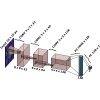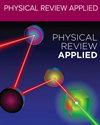Enhanced measurement of neutral-atom qubits with machine learning
IF 4.4
2区 物理与天体物理
Q2 PHYSICS, APPLIED
引用次数: 0
Abstract
We demonstrate qubit-state measurements assisted by a supervised convolutional neural network (CNN) in a neutral-atom quantum processor. We present two CNN architectures for analyzing neutral-atom qubit readout data: a compact five-layer single-qubit CNN architecture and a six-layer multiqubit CNN architecture. We benchmark both architectures against a conventional Gaussian-threshold analysis method. In a sparse array (9- atom separation) which experiences negligible crosstalk, we have observed up to 32% and 56% error reduction for the multiqubit and single-qubit architectures, respectively, as compared to the benchmark. In a tightly spaced array (5- atom separation), which suffers from readout crosstalk, we have observed up to 43% and 32% error reduction in the multiqubit and single-qubit CNN architectures, respectively, as compared to the benchmark. By examining the correlation between the predicted states of neighboring qubits, we have found that the multiqubit CNN architecture reduces the crosstalk correlation by up to 78.5%. This work demonstrates a proof of concept for a CNN network to be implemented as a real-time readout-processing method on a neutral-atom quantum computer, enabling faster readout time and improved fidelity.

利用机器学习增强对中性原子量子比特的测量
我们在中性原子量子处理器中演示了有监督卷积神经网络(CNN)辅助的量子比特态测量。我们提出了两种用于分析中性原子量子比特读出数据的 CNN 架构:紧凑型五层单量子比特 CNN 架构和六层多量子比特 CNN 架构。我们将这两种架构与传统的高斯阈值分析方法进行比较。在可忽略串扰的稀疏阵列(原子间距为 9μm)中,我们观察到多量子比特和单量子比特架构的误差与基准相比分别减少了 32% 和 56%。在存在读出串扰的紧密间距阵列(原子间距为 5μm)中,我们观察到与基准相比,多量子比特和单量子比特 CNN 架构的误差分别减少了 43% 和 32%。通过检查相邻量子比特预测状态之间的相关性,我们发现多量子比特 CNN 架构最多可将串扰相关性降低 78.5%。这项工作证明了在中性原子量子计算机上实现 CNN 网络作为实时读出处理方法的概念,从而实现更快的读出时间和更高的保真度。
本文章由计算机程序翻译,如有差异,请以英文原文为准。
求助全文
约1分钟内获得全文
求助全文
来源期刊

Physical Review Applied
PHYSICS, APPLIED-
CiteScore
7.80
自引率
8.70%
发文量
760
审稿时长
2.5 months
期刊介绍:
Physical Review Applied (PRApplied) publishes high-quality papers that bridge the gap between engineering and physics, and between current and future technologies. PRApplied welcomes papers from both the engineering and physics communities, in academia and industry.
PRApplied focuses on topics including:
Biophysics, bioelectronics, and biomedical engineering,
Device physics,
Electronics,
Technology to harvest, store, and transmit energy, focusing on renewable energy technologies,
Geophysics and space science,
Industrial physics,
Magnetism and spintronics,
Metamaterials,
Microfluidics,
Nonlinear dynamics and pattern formation in natural or manufactured systems,
Nanoscience and nanotechnology,
Optics, optoelectronics, photonics, and photonic devices,
Quantum information processing, both algorithms and hardware,
Soft matter physics, including granular and complex fluids and active matter.
 求助内容:
求助内容: 应助结果提醒方式:
应助结果提醒方式:


